|
CRI
- BANGLADESH
ABOUT -
CONTACTS - FOUNDATION -
HOME - A-Z INDEX
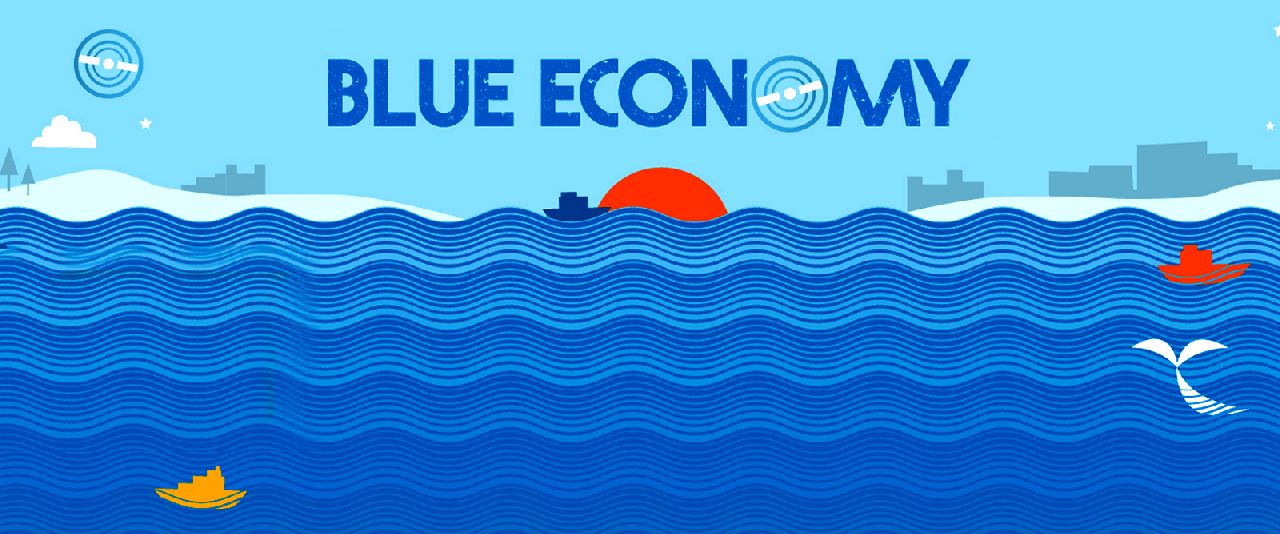
MARINE
LIFE - Humans are for the most part unaware of the harm their fast-lane
lifestyles are causing to marine life as they work 9-5 in
factories and offices, and shopping for food is just a chore
that they cram into evenings or weekends. We aim to change that by doing all we
can to promote ocean
literacy and the potential for
growth of the blue economy with healthier seas and oceans as
the starting point.
The Centre for Research and Information (CRI) is a not-for-profit policy research organization which aims to create a platform for public discussion on important matters of national policy in
Bangladesh. Analyzing key challenges facing the nation, CRI explores through people-centered debate the political ideas and the policy reforms that will define progressive politics and policies in a new, digital Bangladesh. With a focus on youth engagement and democratized debate, CRI aims to bring politics closer to the people.
AIMS
According to their website the CRI believes in the active participation of citizens in matters of national policy. By bridging the gap between people and politics,
the CRI hopes to empower citizens and afford them a stake in their society. The organization aims to generate high quality research and data on the opinions and views of people, especially young people in Bangladesh through creative, revolutionary methods. By doing so, the views of the people are given an unfiltered platform which can influence policy decisions on both a local and national scale.
WHAT THE CRI DOES
The CRI takes a strategic approach to achieving its goals. It combines its resources and expertise with ground-breaking market research and polling aimed at various groups, especially young and student groups, to produce the following:
• High quality research into the concerns and priorities of young voters and the youth demographic in Bangladesh;
• Unique platforms for voicing the opinions of young Bangladeshis, such as Let’s Talk and Policy Café;
• Publications and blogs produced to the highest editorial, design and production standards, whether in print or digital form;
• Pioneering marketing and promotion efforts, through television, radio and social media outlets;
• Cutting-edge media and publicity efforts aimed at and, in some cases, created by and for, young people themselves
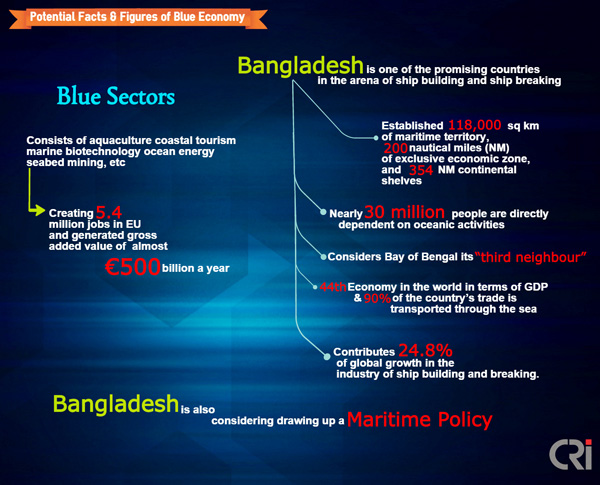
BLUE
ECONOMY CHART - Bangladesh is one of the promising
countries in the arena of ship building and breaking. The
above infographic outlines the other blue sectors where growth
is anticipated.
CRI
NOVEMBER 2014 - BANGLADESH HEADING FOR A BLUE ECONOMY
‘Blue Economy’ is a concept that can significantly contribute to the socio-economic development of Bangladesh. Blue economy concept has ushered in a new horizon for economic development of the coastal countries through utilising the sea and marine resources at national and international level”.
- Prime Minister Sheikh Hasina
The decisive aim of the business model of Blue Economy is to transform the country from scarcity to abundance by tackling issues that cause environmental and related problems in new ways (Gunter Pauli 2010). The potential benefit of Blue Economy is to address economic problems with innovative solutions that are environmentally beneficial and which have financial and wider social benefits.
Blue Growth is the long-term strategy to support sustainable growth in the marine and maritime sectors as a whole. Seas and oceans are drivers for the Blue Economy while technology and knowledge are the twin resources to take control over these resources. The ‘blue’ economy has created roughly 5.4 million jobs in EU alone and generates a gross added value of almost €500 billion a year. Blue sectors are numerous, consisting of aquaculture, coastal tourism, marine biotechnology, ocean energy, seabed mining, etc.
In a developing country like Bangladesh, the role of marine resources in poverty alleviation, acquiring autarky in food production, protecting environmental balance, facing adverse impacts of climate change and other economic activities is unlimited. Alongside the existing land-based development activities, the marine-based economic activities/management of sea and its resources through Blue Economy may be considered as a new horizon for development of the coastal countries and the small island developing states.
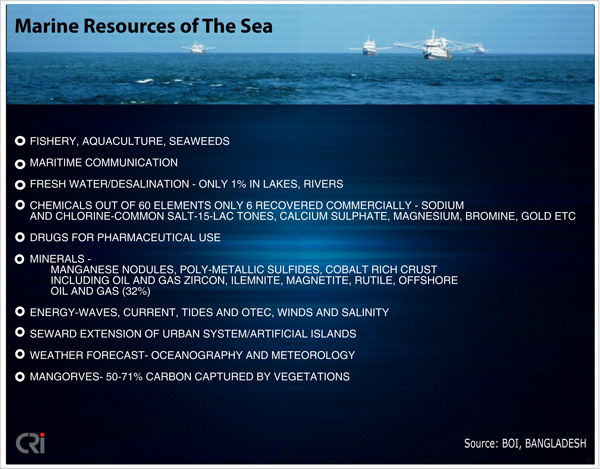
MARINE
RESOURCES - These are the identified main resources for
Bangladesh in the view of the CRI.
The Bay of Bengal: Bangladesh’s ‘third neighbour
Dhaka established its sovereign rights through international court verdicts on more than 118,000 sq km of maritime territory, 200 nautical miles (NM) of exclusive economic zone, and 354 NM continental shelves from the Chittagong coast. It has raised hopes of extracting “plenty of resources” from the Bay of Bengal, considered by Bangladesh as its “third neighbour”. Bangladesh, which lacks expertise and technology to exploit the resources, will seek global partnership, particularly from neighbouring countries.
The peaceful resolution of maritime discords has opened a golden opportunity for Bangladesh to explore and exploit the vast resources in the Bay of Bengal.
Bangladesh, which lacks expertise and technology to exploit the resources, will seek global partnership, particularly from neighbouring countries. Bangladesh is also considering drawing up a maritime policy.
There is no doubt that sea-related subjects like expansion of international trade, use of marine mineral resources for long-term energy security, proper management of marine fish resources and protecting marine environment and bio-diversity would determine Bangladesh’s future development and economic growth.
Bangladesh’s recent activities to enlarge the maritime economic activities assume significance as the substantial part of the country’s foreign trade is conducted through maritime shipping. Besides, Bangladesh is one of the promising countries in the arena of ship building and ship breaking. According to an estimate, the country contributes 24.8% of global growth in the industry of ship building and breaking. Some Bangladeshi observers maintain that in ports like Chittagong and Narayanganj, there are huge opportunities to expand the industry.
Bangladesh’s Strategy towards Blue Development
Considering vast multi-dimensional potentials of the Bay of Bengal, the Father of the Nation, Bangabandhu Sheikh Mujibur Rahman enacted the Territorial Waters and Maritime Zones Act 1974 to establish Bangladesh’s sovereign rights over the sea and its resources. Consequent to this some of the important provisions of Bangladesh’s Territorial Waters and Maritime Zones Act of 1974 were also included in the UNCLOS 1982. Especially the articles 7(2) of the
UNCLOS on deltaic base line for highly unstable coastline were incorporated due to insistence of Bangladesh.
A huge stock of living and non-living resources is available under the seabed and water column. But we have a dearth of skilled manpower to ascertain the availability and explore the resources. Besides, there is also lack of proper technology for exploiting deep sea fishes and seabed resources. To build skilled manpower in these sectors, the country has taken steps to impart higher education on
Oceanography at the Dhaka University and Chittagong University. The first National Oceanographic Research Institute’ is being established at Ramu, Cox’s Bazar to create a marine scientific community for research.
Nearly 30 million people are directly dependent on oceanic activities like fisheries and commercial transportation for their livelihood. Bangladesh considers Bay of Bengal its “third neighbour”. The Ministry of Foreign Affairs is about to draft a national maritime policy for the first time.
Bangladesh to work together for people-centric blue economy
Bangladesh wants to work together and move ahead with a ‘Bay of Bengal partnership for Blue Economy’ to secure sustainable development among the coastal or littoral states ensuring an inclusive and people-centric blue economy.
Foreign Minister AH Mahmood Ali while summing up the two-day international workshop on ‘Blue Economy’ in the city on Tuesday. He said there needs to have collaboration in research, observation and surveillance; and in respect of sharing of analyses, outcomes and observations. “And, such collaboration among countries must take place based on certain universal principles of engagement-mutual trust, respect, mutual benefits and equitable sharing of benefits,” said the Foreign Minister.
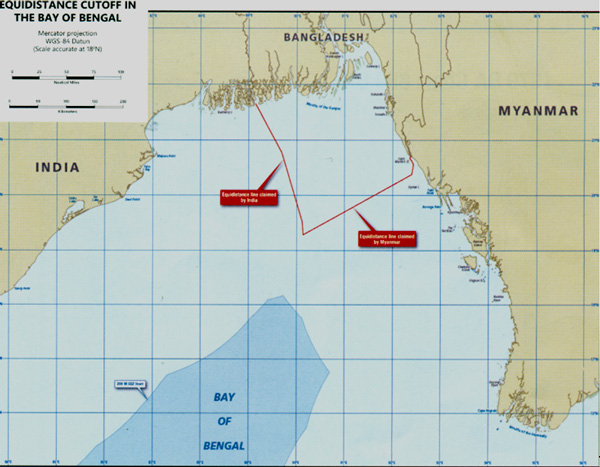
GEOGRAPHY -
The sovereign territory of Bangladesh as it relates to the Bay
of Bengal.
The Potential
History of development of many countries tells us that the countries which utilized the sea and its resources became economically more prosperous than others. Bangladesh should be of no exception to this development. Our international trade is totally sea borne. With 130
billion dollar GDP, Bangladesh’s economy is the 44th in the world in terms of GDP. Export earning surpasses 30 billion
dollar mark. The total international trade comprising export and import stands at 65 billion dollar. With more than 6 percent GDP growth, Bangladesh’s economy is advancing towards a prosperous future. An increased export is crucial for economic uplift and growth. Today, 90% of the country’s trade is transported through the sea.
Now we should be more concerned to harness the new maritime territory. We do not have accurate information about the total stock of all resources we have in the Bay of Bengal. In 1975, FAO Consultant Dr. W B West conducted a survey which found that the Bay of Bengal had around 264,000 to 3,74000 mt tons of fish and 9,000 mt of shrimps. We need to find out and update the figures from newer surveys.
There are about 435 species of fish available in the Bay of Bengal region. The total collection of fish from the Bay is approximately 6 million tonnes annually, but Bangladesh’s share in it is meagre 0.29 million tonnes. On July 12, Fisheries and Livestock Minister Mohammad Sayedul Haque met Director General of Food and Agriculture Organisation (FAO) in the United Nations, J D de Silva in Rome and urged him to include Bangladesh in FAO’s “Blue Economy Initiative” which is increasingly becoming popular across the world.
Beyond Fisheries
Besides fish resources, there are mineral resources in the seabed. Salt is one of the important resources that meet our daily needs. However, Bangladesh’s salt production has remained stagnant at 350 TH MT since 2003, as per
United States Geological Survey (USGS) Minerals Resources Program (2009). Salt industries have been set up in the coastal areas and there are about 300 refining units. Production of industrial salt can be done using advanced technologies and eventually it can become an export product.
Other mineral resources beneficial to Bangladesh, as mentioned at the BoI seminar, are gas, copper, magnesium, nickel and precious metals, including cobalt. Like many developed countries, Bangladesh can also utilise the sea for producing renewable electricity. In addition, some industrial sectors such as ship-building and ship-breaking industries and pharmaceuticals can also benefit from the sea resources.
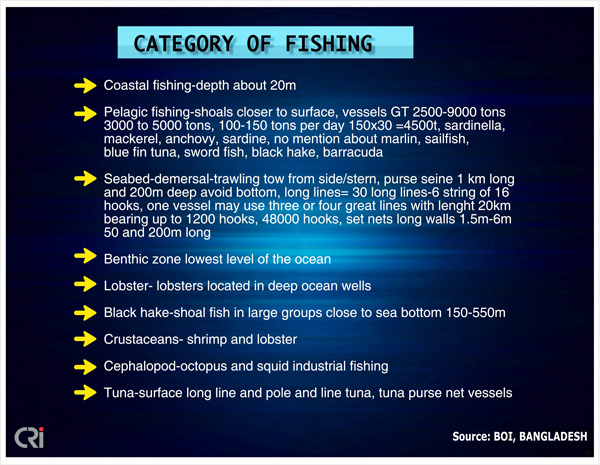
FISHING
CATEGORY - This infographic indicates the limits and
techniques used in Bangladesh waters as compiled by BOI.
UNITED
NATIONS FAO: ASIA
AND PACIFIC BLUE GROWTH INITIATIVE
At the 32nd FAO Regional Conference for Asia and the Pacific held in Ulaanbaatar, Mongolia in March 2014, member countries endorsed the regional initiative on sustainable intensification of aquaculture for
blue growth – improving fish supply for food and nutrition, increasing livelihood opportunities and contributing to blue growth of economy through more efficient and sustainable use of aquaculture resources.
The objectives of the regional initiative are:
1. Improve the utilization efficiency to aquaculture resources.
2. Improve production efficiency with reduced impacts on the environment.
3. Increase the resilience of farmers and the sector.
4. Improve the equity and social acceptability along the aquaculture value chain.
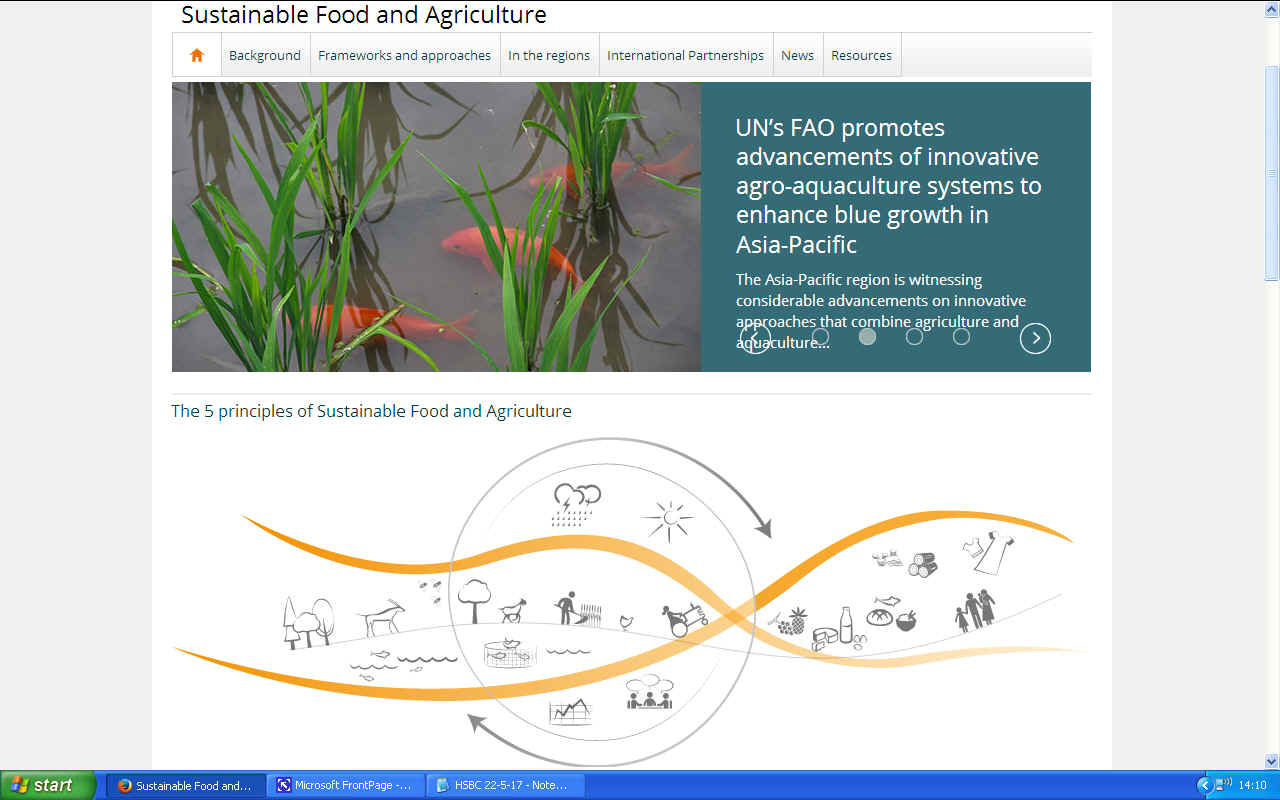
Major areas of work of the regional initiative
* Support member countries in identifying options for addressing key governance issues in achieving sustainable aquaculture growth through appropriate regional and national consultation process, develop relevant regional and national policy, strategy and action plan.
* Increase farmers’ adaptability to climate change impact and resilience to natural disasters and socioeconomic risks through development and promote innovative
aquaculture management concept and practices.
* Reduce negative environmental and social impacts of aquaculture intensification and through promoting innovative
farming technologies and management practices, establishing effective aquaculture bio-security and disease surveillance and control system, application appropriate planning and management tools and responsible use of resources.
* Support the member governments in improving the access of poor rural aquaculture farmers to quality production inputs, sustainable production technology and market for improved productivity and economic efficiency.
* Improve management of forestry (mangrove), water, land and tenure that will contribute to sustainable intensification of
aquaculture.
In Asia,
fish currently supplies about 20 percent of the protein in people’s diets. Due to the increasing population and economic growth, by
2030 fish consumption in Asia is estimated to surge by 30 percent.
Aquaculture is seen as the only way to meet the increasing demand due to the stagnant production from capture fisheries.
[requiring
regeneration]
The goal of this regional initiative is to achieve sustainable growth of Asian Aquaculture, which will contribute to
food and nutrition security through meeting increasing regional and world demand for fish, poverty alleviation by making aquaculture an attractive and resilient livelihood and overall contribute to economic development in the region.
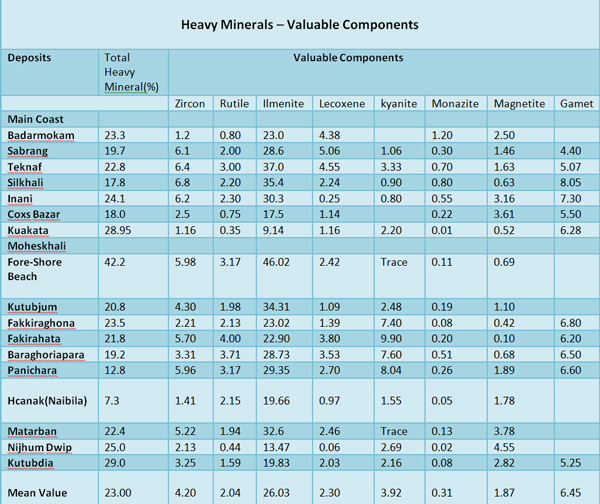
SEABED
MINING
- A chart showing the concentrations of valuable mineral
deposits such as Zircon and Magnetite, indicates the potential
for blue growth - provided that the harvesting is achieved
sensitively.

CRI
CONTACTS
Centre for Research and Information (CRI)
House 2, Road 32 (old) 11 (new)
Mirpur Road, Dhanmondi
Dhaka 1209, Bangladesh
Tel: +88029111260
Fax: +88029111319
Email: info@cri.org.bd
Facebook:
https://www.facebook.com/cri.bangladesh
LINKS
& REFERENCE
http://www.fao.org/asiapacific/perspectives/blue-growth/en/
http://www.fao.org/asiapacific/perspectives/blue-growth/en/
http://cri.org.bd/2014/11/02/bangladesh-heading-towards-blue-growth/
http://www.oecd.org/futures/oceaneconomy.htm
http://www.theblueeconomy.org/the-book.html
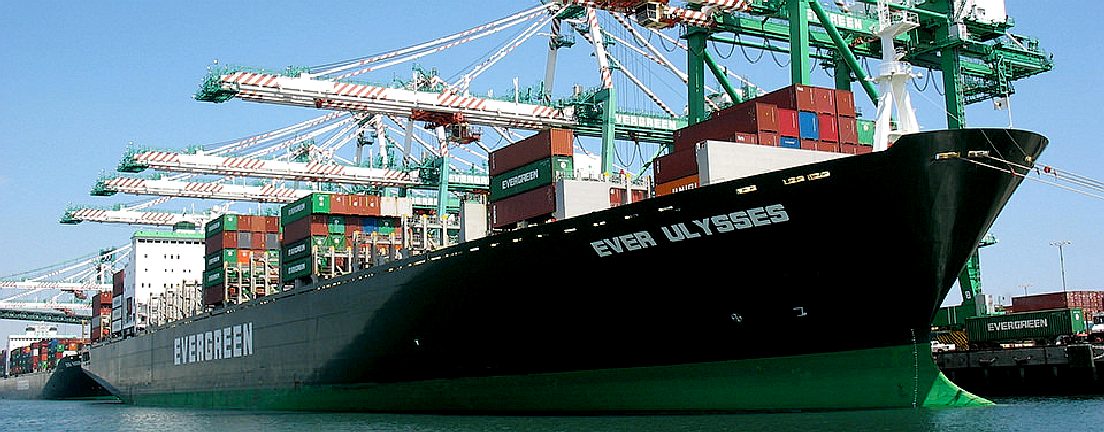
This
website is provided on a free basis as a public information
service. Copyright © Cleaner
Oceans Foundation Ltd (COFL) (Company No: 4674774)
July 2017. Solar
Studios, BN271RF, United Kingdom.
COFL
is a charity without share capital.
|








